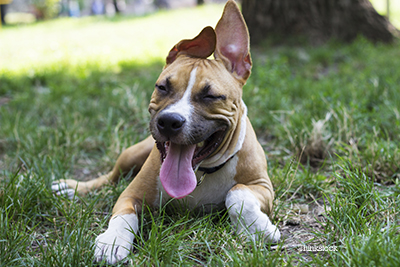There is an old saying that couldn't be truer: "A tired dog is a good dog."
Just like with people, when dogs receive a healthy balance of physical and mental stimulation, they will be happy and well-adjusted. Your dog wakes up each morning with a certain amount of physical and mental energy that he or she needs to expend to feel happy, occupied, and balanced. What your dog needs will be different from other dogs; breed, age, size, and individual temperament all contribute to this, as does your dog's mood on any given day.
Dogs that don't receive adequate stimulation for their bodies and their brains might be restless, destructive, hard to train, and even in the worst cases, aggressive and irritable (just like people!).
Here's our advice for helping your dog find a happy balance:
To each his own
Consider your dog -- his age, breed, temperament, energy level, and overall health impact what kind of stimulation and activity will best. A dog who is naturally a couch potato isn't a dog that you need to take on 5-mile hikes, and a dog that is bouncing off the walls 18 hours a day won't be satisfied with a walk around the block.
Experiment and mix it up
To keep things interesting for your dog, and for you, be sure to address your dog's need for both physical and mental stimulation. If your dog loves to run, then make sure you give him or her plenty of time to let out that physical energy. But make sure you also engage his brain, whether it's through some obedience training (learning a new trick actually can take a lot of energy for a dog) or solving a problem (like getting food out of a toy designed to hold some kibble). A dog that gets only physical exercise could still have a very unsatisfied and "wired" mind and that can lead to destructive behavior or just a restless pooch.
Doggie daycare and play groups can be an excellent chance for your dog to expend a lot of physical energy and learn how to get along with other dogs. However, even after a long day of playing at daycare, your dog might still need some mental engagement, which could be satisfied by a little focused obedience work between the two of you. Think about your dog's activity as though it's on an old-fashioned scale -- if he or she has a heavy dose of playing and running, balance it with some calm and quiet focused time learning a new trick (and yes, old dogs can learn new tricks).
Think about your dog's activity as though it's on an old-fashioned scale -- if he or she has a heavy dose of playing and running, balance it with some calm and quiet focused time learning a new trick (and yes, old dogs can learn new tricks).
Bonding with your pup
Strengthen your bond with your dog by including activities that bring you and your dog closer and have you working together. Jogging with your dog, playing fetch, hiking and climbing, playing frisbee, and many other activities present opportunities for you to connect with your dog and serve as the primary focus of his or her attention. This helps tighten the bond and connection between you and your pet and will be more rewarding for both of you.
"Me time": give your dog some space
Your dog needs "Me time." Every dog has to spend time alone and it's important that he or she is comfortable and not stressed when alone. This kind of "me time" is often enhanced by providing your dog with things to stay busy -- toys that you can hide food in, chew toys, or some of the new and cool automated toys that release a ball or a treat at regular intervals are all great ways to help a dog enjoy being alone.
Finally, remember that just like you, your dog will need different things at different stages during his or her life. Puppies get tired quickly and short bursts of mental or physical activitiy interspersed with naps can work perfectly. Younger adult dogs might need extended, more intense periods of stimulation. And our senior friends might need something entirely different.
If you have any questions or concerns, you should always visit or call your veterinarian – they are your best resource to ensure the health and well-being of your pets.
